 An outdoor melon? Another new breeding programme? Yes, this year Lubera has started breeding melons, more precisely honeydew outdoor melons for Central Europe. Lubera has already bred some exotic crops: you can already order peanuts, sweet potatoes or passion fruit in the Lubera Garden Shop, but now outdoor melons? Do they even grow here?
An outdoor melon? Another new breeding programme? Yes, this year Lubera has started breeding melons, more precisely honeydew outdoor melons for Central Europe. Lubera has already bred some exotic crops: you can already order peanuts, sweet potatoes or passion fruit in the Lubera Garden Shop, but now outdoor melons? Do they even grow here?
It's not that far-fetched to grow outdoor melons in Germany, Austria or Switzerland. If you look in old variety catalogues, you will be surprised to find that melons were grown in Germany more than 100 years ago. There you will read about Berlin net melons, the Konsul-Schiller-Kantalupe melon, the delicious Pillnitz melon, Heinemann's field melon, the Opalkugel or the melon variety 'Kaiserin Auguste-Viktoria'.
Table of contents
- Why are there so few outdoor melons in our region today?
- How did Lubera get into melons?
- My story with the outdoor melon
- What goals for a new Lubera melon?
- What makes a 'simple' outdoor melon?
- The first breeding step: variety screening
- Old varieties for the cool north
- Modern French Charentais melons: resistance and sweetness
- Diversity: from tiger melons to monsters
- Melon varieties: open-pollinated, F1 hybrids or populations?
- Open-pollinated varieties
- F1 hybrid varieties
- Population varieties
- Is it absolutely necessary to propagate an outdoor melon by seed?
- And what about watermelons?
- New outdoor melons for the future
- Impressions of the melon breeding field at Lubera in Buchs, Switzerland
Why are there so few outdoor melons in our region today?
So why does the melon seem to be such an exotic fruit today? There are three reasons. Firstly, the cultivation of melons was quite laborious even back then. Cold frames, manure beds and similar elaborate techniques were used in order to be able to harvest some expensive fruit with a lot of effort. So it was only natural that - secondly - the cultivation of such luxury goods as melons declined very much due to the two world wars. People now had to feed as many people as possible and could not afford such costly and low-yielding fruits. And thirdly, the final nail in the coffin for the northern European melon varieties came with ever-improving transport and open borders in Europe and worldwide. Why grow melons in Germany under difficult conditions when they can be produced totally cheaply in Spain and then transported to Germany by lorry? Unfortunately, melons have become rare in the gardens of Germany, Austria and Switzerland.
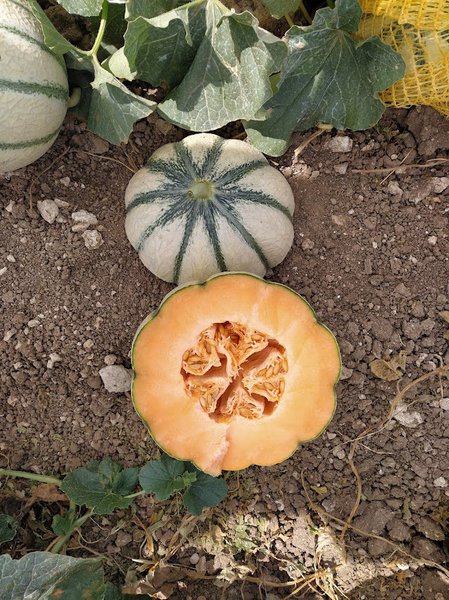
Picture: Melons have become rare in our gardens.
How did Lubera get into melons?
But how did Lubera decide to start a melon breeding programme? On the one hand, we at Lubera made the decision a few years ago to focus more specifically on vegetable breeding in the future, and melons as 'fruit vegetables' are part of this. On the other hand, I myself am to blame for this melon programme and have almost pushed Lubera to start with melons.
My story with the outdoor melon
Years ago, during my school days, I dreamed of growing melons. For me, melons were the epitome of great exotic summer fruit and it would be brilliant to be able to grow something like that in my own garden. At that time, I was given a garden plot by my grandparents on the edge of the Swabian Alb to garden and experiment with. Of course, I set to work with little knowledge, but all the more enthusiasm. I grew my first melons from the seeds of a yellow Canary melon from the supermarket. I nurtured them, protected them with foil when it froze, and watered them diligently when it was dry. The result was not exactly stunning. With a lot of effort and work, I was able to harvest some half-ripe melons at the end of September. But I was not discouraged by this, instead, I said to myself: it almost worked, if I just grow the right variety, it should actually be possible.
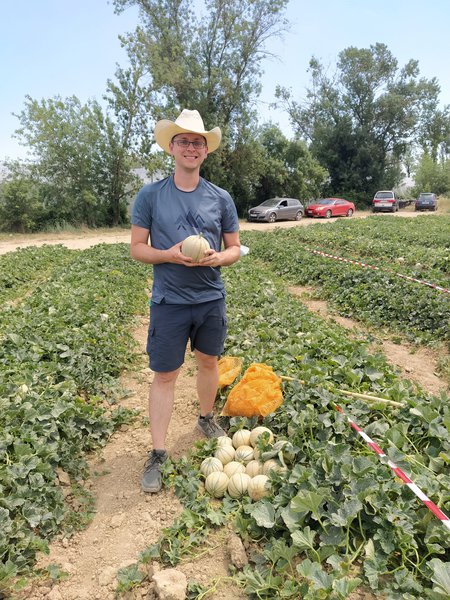
Picture: Raphael Maier during his horticultural studies in a melon field near Toulouse, France.
Several years later, during my horticultural studies, I had the opportunity to work in melon cultivation in the southwest of France. During those five months near Toulouse, I learned a lot about growing and breeding melons. And even after having to eat and test 10 different types of melons almost every day, I still didn't dislike melons. On the contrary, I was now even more convinced that one could actually breed new outdoor melon varieties for the cooler regions of Central Europe. And so I managed to persuade the Lubera team to start an outdoor melon breeding programme. In all honesty, I have to admit that this was not very difficult because Lubera also loves melons and is convinced that they deserve a place in the garden.
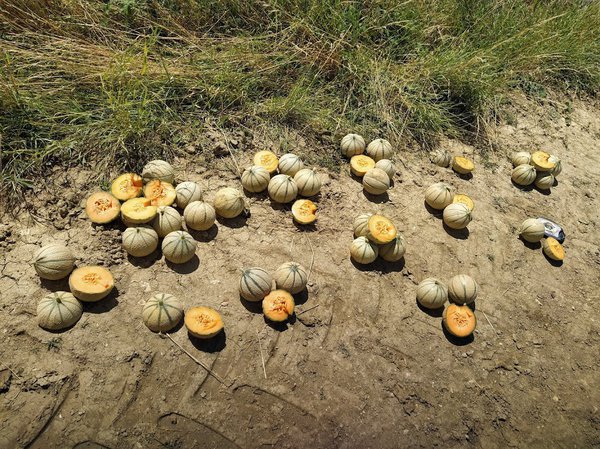
Picture: Comparison of different melon varieties from the test field in France.
What goals for a new Lubera melon?
Now I was faced with the challenge: how do you start a new outdoor melon breeding programme? Where do you start? What are the goals for growing melons? The latter was quickly defined: we want new melon varieties that can be grown in the field without much effort. In addition, some diversity would be great: compact varieties for growing on the terrace, different fruit colours, shapes and sizes.
What makes a 'simple' outdoor melon?
So the rough lines are now set. But what makes a melon a 'simple' outdoor melon?
- The plant grows very vigorously even in bad weather
- The melon plant is healthy, robust and not very susceptible to disease
- Fruits are easily formed and ripen in time
- The fruits look beautiful and are aromatic and sweet
Behind these four simple points is a whole catalogue of requirements. Melons need very high temperatures; below 18°C most melon varieties practically do not grow. Therefore, varieties that also grow at cool temperatures would be advantageous. The development of a melon from planting to ripe fruit takes between 120 and 150 days, depending on the variety, weather and season. Varieties with a short vegetation cycle should therefore be bred in order to harvest ripe fruit even in bad weather. Numerous diseases and pests can attack melon plants and destroy the plants and melon fruits within a very short time. Melon pests include aphid-borne viruses, fusarium wilt, bacteriosis, powdery mildew, verticillium, etc. Many disease symptoms are particularly common in cool and rainy weather. Accordingly, we need particularly resistant varieties for our outdoor melon breeding programme. In cool temperatures, many melon varieties drop their young fruits or do not fertilise properly, so we need varieties that produce fruit despite adverse conditions. But where do we get all these characteristics for our new melon varieties?
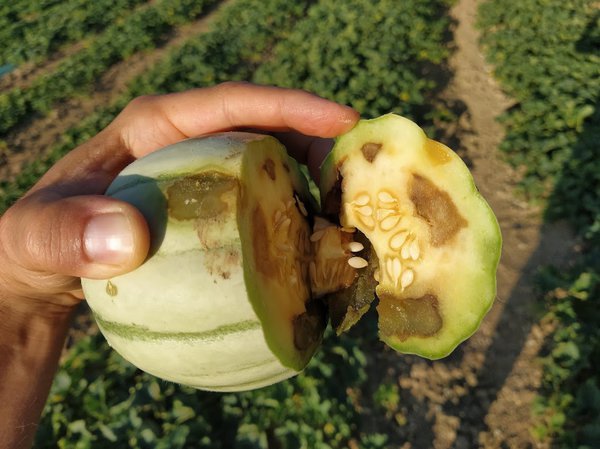
Picture: A melon that has been attacked by bacteriosis.
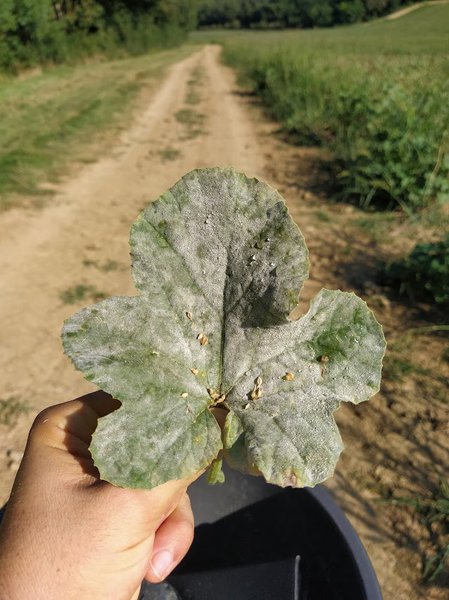
Picture: Powdery mildew is a typical disease that can affect melon leaves.
The first breeding step: variety screening
The first step in breeding is actually always to screen existing varieties. This is done by selecting promising varieties and planting them to see how they behave in our climate. Maybe there are already super varieties that have exactly the characteristics we are looking for. In that case, we just have to find them, propagate them and market them. Most of the time, however, this is not the case; we find varieties that have individual positive characteristics that we can then combine in future years. For example, one variety may be very robust and disease-resistant, but with bad-tasting fruit. The next variety might produce sweet, aromatic, melt-in-the-mouth fruit, but be very susceptible to disease. Then it would be worth crossing these varieties to get the best out of both.
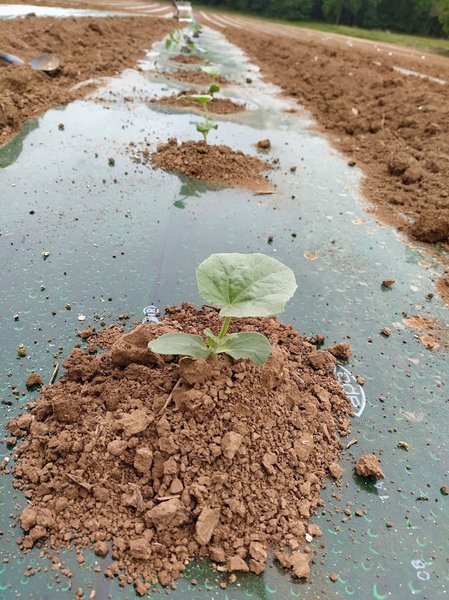
Picture: Planting out young melon plants in the test field.
Old varieties for the cool north
In order to cover all the necessary characteristics, we have planted out over 150 different melon varieties in our breeding facility in Buchs, Switzerland and are now putting them through their paces. The varieties tested should have all the necessary characteristics. The most important criterion, i.e. adaptation to short, cool and humid summers will hopefully be provided by old varieties from Germany, France, Sweden and the Baltic States. Among these old melon varieties is, for example, the melon 'Petit Gris de Rennes', which was discovered more than 400 years ago in the garden of the Bishop of Rennes and has been grown every year since in cool, humid Brittany. There is also, for example, 'Hammenhögs Frilandsmelon', which comes from Sweden, which is truly not known for its melons.
Apart from the old northern European varieties, we also test newer variety mixes such as the 'Farthest North Mix' by Tim Peters from the U.S .state of Oregon, which are specially selected for a short growing season in cool regions.
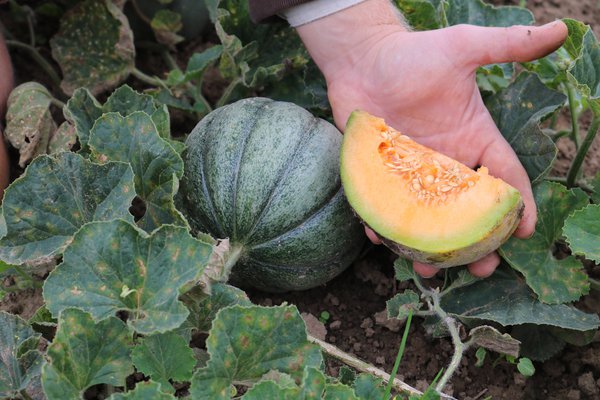
Picture: The old, cold-tolerant melon variety 'Oka du Quebec' from Canada.
Modern French Charentais melons: resistance and sweetness
Some of the breeding material comes from modern French varieties. In France, the Charentais melon has a very different status than in Germany. There, a real melon is always a Charentais melon and not a Galia or Yellow Canary. The cultivation and consumption of the fruit has a centuries-old tradition there and even today almost a dozen companies breed new varieties every year. These modern hybrid varieties bring a few advantages that many older varieties lack. For example, most old melon varieties are unfortunately not really sweet, which is why particularly sweet varieties of Charentais melons (Brix content of 18°) were included in the variety review. Furthermore, these varieties are usually more productive and partly also earlier ripening. A final major advantage is the disease resistance of the newer French varieties. They possess a naturally occurring gene variant of the VAT gene, which makes the melon plants immune to aphids and viruses, and they are usually less susceptible to various fungal diseases.
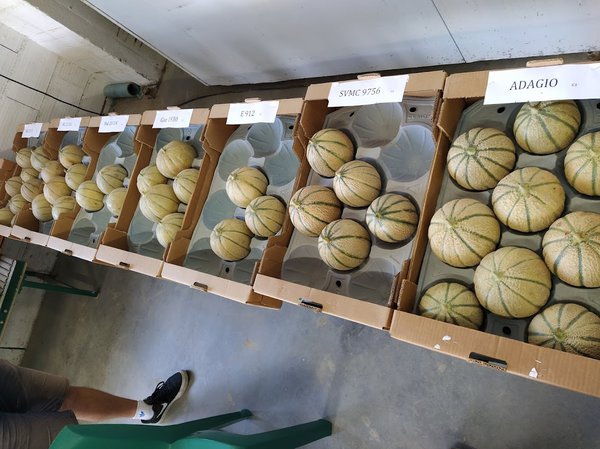
Picture: Comparison of modern French Charentais melon varieties.
Diversity: from tiger melons to monsters
Diversity is always close to our hearts, and it is particularly great in the case of melons. There are honeydew melons with white, orange or green flesh, melon varieties that only produce tennis ball-sized fruits, and others that produce almost 20-kilo monsters. The skin can be wafer-thin and smooth or several centimetres thick and warty. The shape of the melon fruit ranges from round to very strongly ribbed to oval or simply misshapen. This variety is already partly contained in the previously described varieties, but in order to cover and try out an even wider range, we have numerous varieties from Pakistan to Japan in our breeding field. These include the beautifully yellow-orange striped tiger melon as well as the Turkish Kasaba melon with its extremely wrinkled yellow skin with green dots.
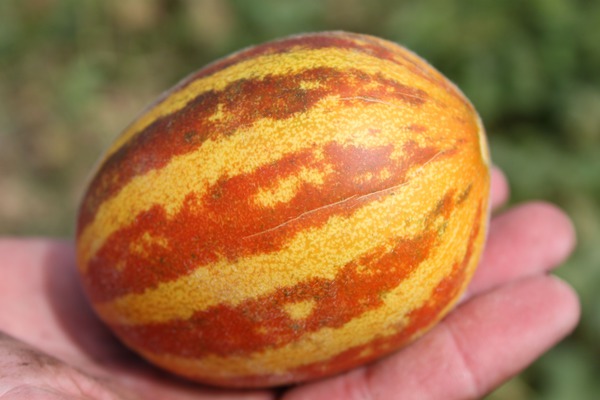
Picture: The beautiful, yellow-red striped tiger melon.
Melon varieties: open-pollinated, F1 hybrids or populations?
Now that we have examined and hopefully tasted the individual varieties this year, the questions will be this: how do we proceed? What kind of varieties do we develop? Normally melons are propagated by seed. There are four different types of varieties:
Open-pollinated varieties
The first type of melon varieties are open-pollinated melons. Here, a particular plant is selected from a population. This plant is then pollinated over several generations only with pollen from its own flowers. After several generations, you have a pure line that produces more or less the same fruit every year. However, these varieties that breed true have the disadvantage that they have been inbred over many generations, which means that the plants are generally weaker and yield less than other varieties.
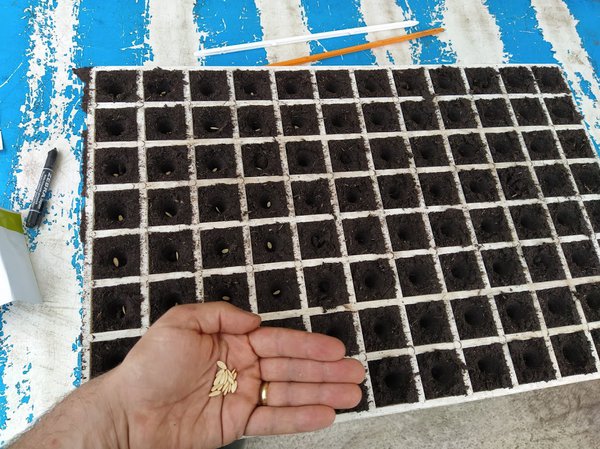
Picture: Sowing melon seeds in a multi-cell tray.
F1 hybrid varieties
To get around this shortcoming, you can cross two seed-stable varieties with each other and then get a so-called F1 hybrid. These plants again all look the same but are much more vigorous and stronger than their parents. The disadvantage of F1 hybrids is that they are not stable and split again in the next generation, which means that if you sow seeds from such fruits, both large and smaller, both weak and strong plants can come out.
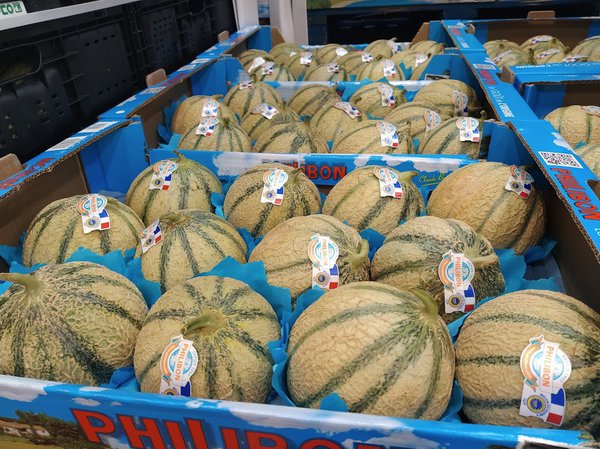
Picture:Beautifully uniform fruits of modern F1 hybrid varieties.
Population varieties
The last type of varieties are so-called population varieties. In contrast to the open-pollinated varieties, these are not only the result of a single fruit but a mixture of many fruits. They are much less uniform than open-pollinated varieties, they have more diversity and do not have the problem of inbreeding depression, but every plant is different. In a way, you get a good bag of seeds that are all similar, but not the same.
It is not yet clear which variety we will finally choose. Maybe there will be different ones: the population variety for the variety lover, the hybrid variety for the professional gardener and the open-pollinated variety for the seed collector.
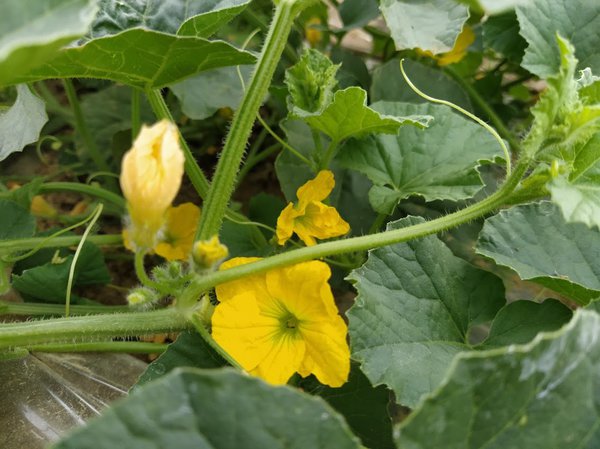
Picture: Flowering melon plants.
Is it absolutely necessary to propagate an outdoor melon by seed?
Here at Lubera, we thought the following: but couldn't we do it differently? To get a pure line for a seed-resistant variety or an F1 hybrid, it takes six to seven generations and that is a lot of time that is lost. If we propagate plants not by seed but by cuttings or by tissue culture in the laboratory, we could propagate a great plant as a variety immediately, i.e. within one year. This would allow us to make much faster progress with breeding and you, as a gardener, would receive new great varieties of outdoor melons for your garden much more quickly. However, at the moment this is still a dream of the future and we first have to try out whether this plan can actually be put into practice. After all, we are currently using exactly this method in tomato breeding to speed up the breeding process and the introduction of new varieties.
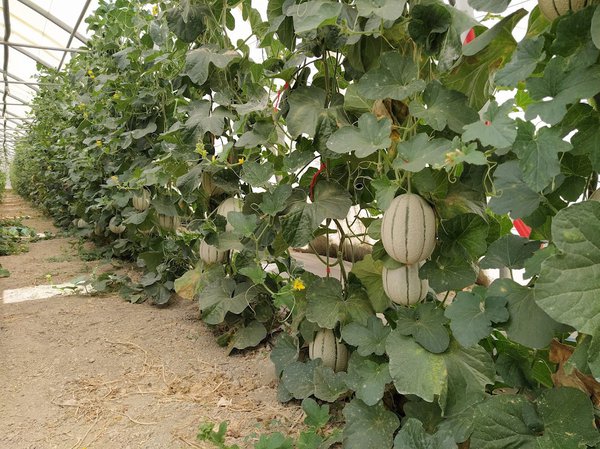
Picture: View into a greenhouse for growing Charentaise melons.
And what about watermelons?
Now I'm writing a long article about melons and I don't mention watermelons at all? Yes, at the moment our focus is clearly on honeydew melons and not (yet) on watermelons. Why? There are two reasons: on the one hand, watermelons have a somewhat higher heat requirement than honeydew melons and usually need more space. On the other hand, most modern watermelons are seedless and thus not suitable for breeding. To create such seedless varieties, normal diploid (two chromosome set) watermelon varieties are crossed with artificially created tetraploid (four chromosome set) varieties. The result is the beautiful (almost) seedless triploid varieties. This is certainly welcome for you as a consumer if the watermelon has no seeds, and for seed producers as well, since no one can copy their varieties. But for us as (new) breeders this is of course...rather stupid. Despite all this, we have not completely forgotten the watermelon and are currently testing 10 different varieties in order to perhaps integrate watermelons into our breeding programme in one or two years.
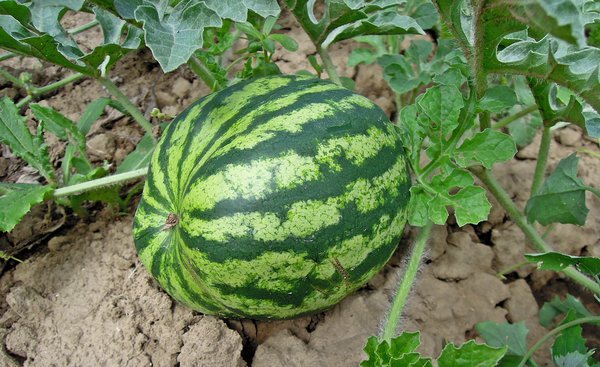
Picture: A large watermelon in the field.
New outdoor melons for the future
No matter how we do it in the end: whether as seed-propagated varieties or as seedlings propagated in vitro, whether honeydew melons or watermelons, you can look forward to future new outdoor melon varieties for the open field. We are working hard towards this goal and are confident that in a few years you will be able to grow new varieties that will reliably produce delicious melon fruits in your garden every year. In any case, I am very excited and can hardly wait to present you with the ripe fruits of our breeding fields.

Picture: A foretaste of the future melon variety.
Impressions of the melon breeding field at Lubera in Buchs, Switzerland
In the following, we show you a few impressions from our melon breeding field.
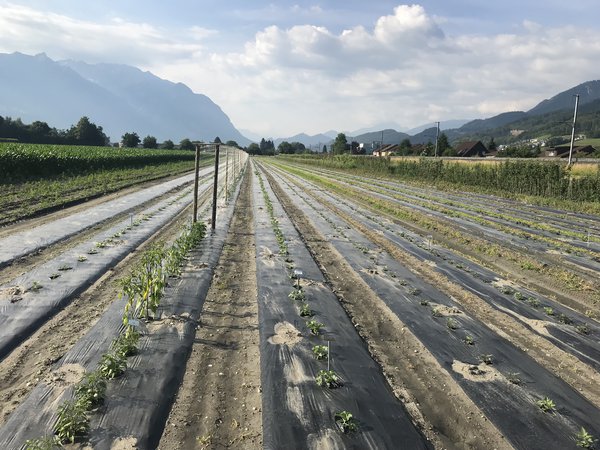
Picture: Between tomatoes and sweet potatoes, melons together with chillies occupy an entire breeding strip (approx. 500 metres long).
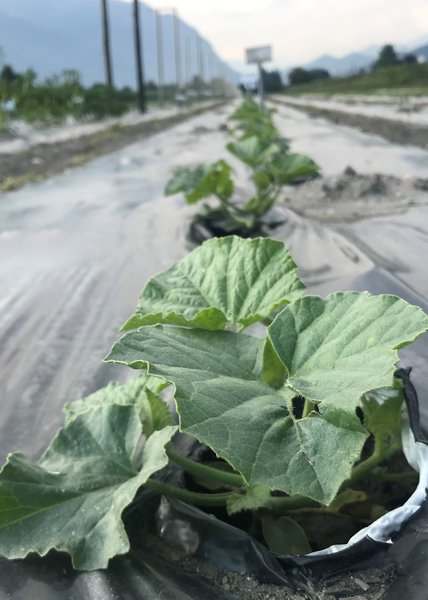
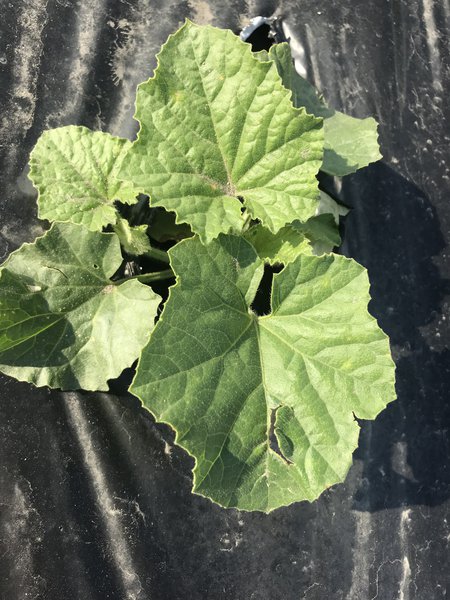
Pictures: Two candidate varieties from the Lubera melon breeding programme.
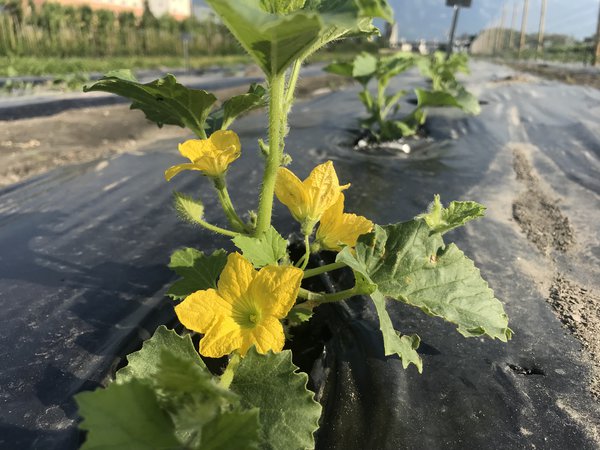
Picture: The wide-open flowers of a candidate variety.
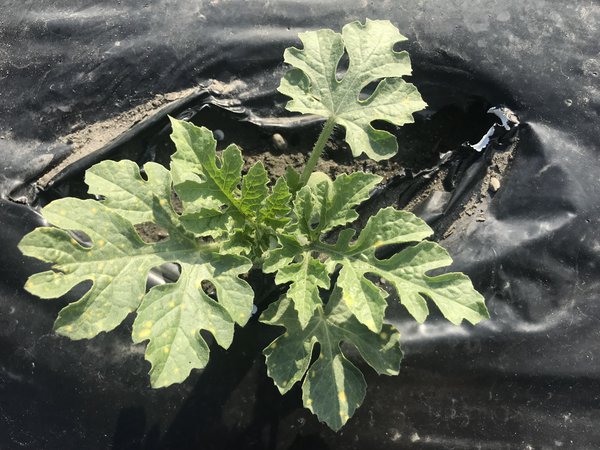
Picture: The leaves of the watermelon 'Moon & Stars dark'.
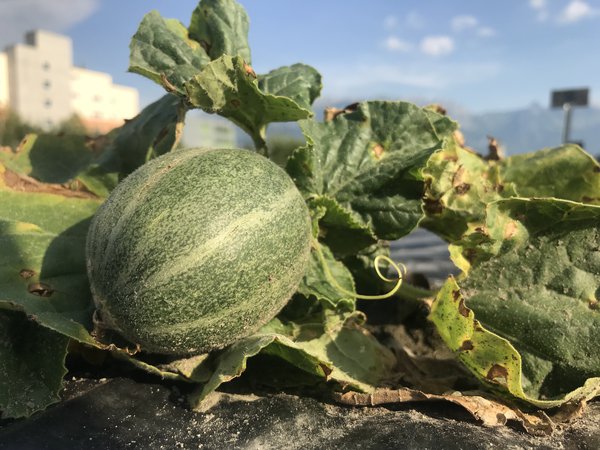
Picture: Fruits can already be seen on the 'Honey Bun' honeydew melon.
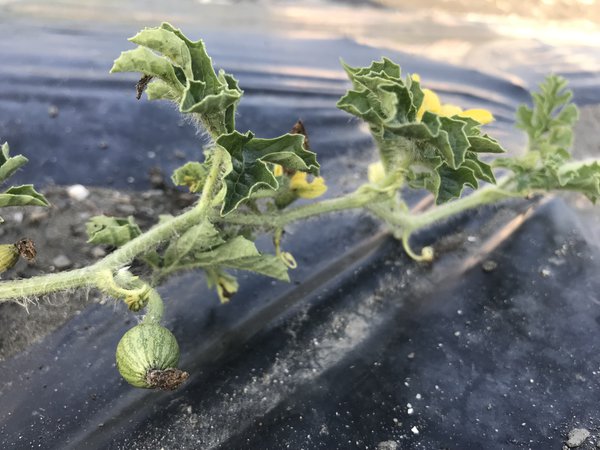
Picture: The watermelon 'Blacktail Mountain' has also already set fruit.
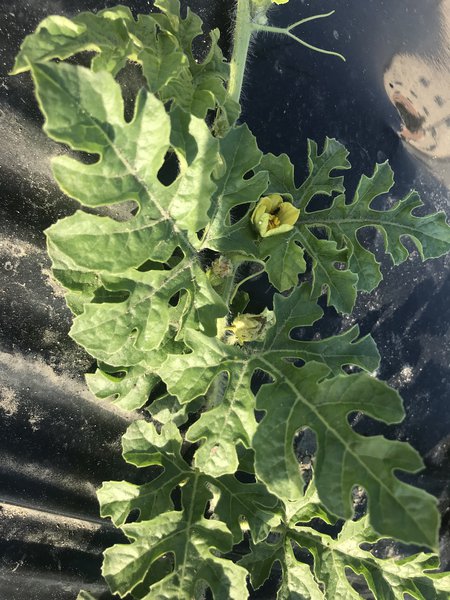
Picture: The foliage of the honeydew melon 'Orangeglo'.
